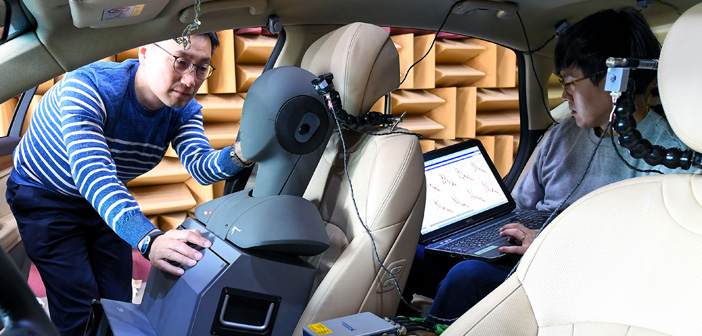Hyundai Motor Group has announced the development of what it claims is the world’s first Road Noise Active Noise Control (RANC) system. The system is said to dramatically reduce noise within the cabin of a vehicle and will be applied to an upcoming Genesis model.
RANC builds on the group’s current Active Noise Control (ANC) technology, which actively reduces noise by emitting soundwaves inverted to incoming noise. However, due to the limitations of noise measurement and analysis technology, the existing ANC is only able to be utilized when noise is constant and the occurrence of the noise predictable. The technology has been most commonly used to counteract constant engine noise. Given that it only takes about 0.009 seconds for road or engine noise to reach the passenger, Hyundai says that the current technology was limited.
The capabilities of the new RANC technology are greater. The new system, which was six years in development, can analyze various types of noise in real time and produce inverted soundwaves. For example, there are different types of road noises that the new technology can process, such as resonant sounds created between tires and wheels or rumble sounds coming up from the road.
Using an acceleration sensor, RANC calculates the vibration from the road to the car and the control computer analyzes road noise. As its computation and signal transfer speeds are optimized, it only takes 0.002 seconds to analyze the noise and for the DSP (digital signal processor) to generate an inverted soundwave. The microphone constantly monitors the road noise cancelation status and sends the information to the DSP. RANC is able to conduct accurate noise analysis and rapid computation to combat road noise for the driver’s seat, the passenger seat and rear seats separately.
Hyundai says that, based on tests evaluating road surface, vehicle speed and different seating positions, RANC was able to reduce in-cabin noise by 3dB. That level is roughly half the noise level compared with a vehicle without RANC. Thanks to this achievement, the group believes it can potentially decrease the amount of weight in a vehicle, utilizing fewer sound-insulating parts and dampers than before.
Partners on the RANC development project included Korea Advanced Institute of Science and Technology, WeAcom, ARE and BurnYoung. The mass production phase was carried out with global car audio company Harman, “to increase degree of competition,” according to Hyundai. It has completed domestic and American patent applications for the location of the sensors and the signal selection method, the core technology of RANC.
“RANC takes existing NVH technology to the next level,” said Gangdeok Lee, a research fellow at the company’s NVH research lab. “We will continue to take the leading position in NVH technology and deliver the highest level of quietness to customers.”



